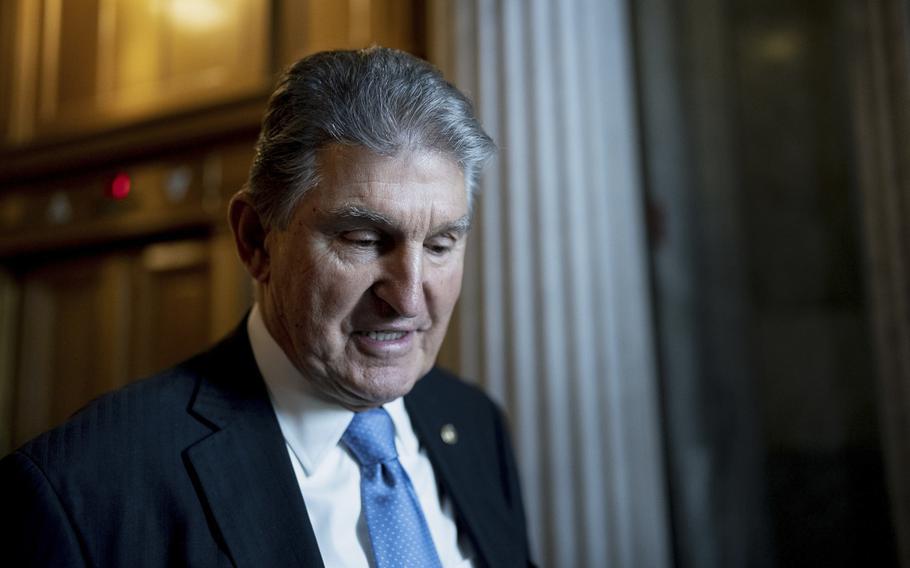
Sen. Joe Manchin, D-W.Va., departs the Senate Chamber at the U.S. Capitol in Washington, D.C., on Dec. 9, 2021. (Stefani Reynolds/Bloomberg)
Last week’s enactment of the 2022 budget-reconciliation bill, also known as the Inflation Reduction Act, is being treated by many analysts as a major turning point in Joe Biden’s presidency.
As recently as last month, when it looked like Congress might not pass reconciliation legislation this year, conventional wisdom in Washington suggested that Biden was a failing president who shouldn’t even consider seeking a second term. But once the IRA unexpectedly secured sufficient support, Biden enjoyed an immediate reputational rebound as a master of legislative achievement; a few hyperbolic responses even compared him to Great Society-era Lyndon Johnson.
This wasn’t too surprising. Americans usually regard the president as the gravitational center around which the entire political universe revolves, responsible for almost everything — good and bad — that happens on his watch. But the events of the past few weeks demonstrate how much this view can distort the more complicated truth. What changed between July and August wasn’t Biden’s presidential acumen, but rather the behavior of a single key senator: Joe Manchin of West Virginia.
Despite the credit he received for its passage, Biden had little involvement in crafting the bill he happily signed into law last Tuesday. The policy areas addressed by the IRA reflected Manchin’s preferences more than those of the president or any other public official. It was Manchin who compelled Biden to settle for a bill much smaller in scope and cost than the White House originally favored, Manchin whose open skepticism earlier this summer had seemed to sink the prospects of reconciliation legislation passing at all, and Manchin (along with fellow moderate Kyrsten Sinema) who was responsible for many of the specific provisions included in the final product. He even forced a change in the bill’s name, pointedly abandoning a previous title that had echoed Biden’s “Build Back Better” campaign slogan in favor of a strategic rebranding.
There’s nothing unusual about moderates like Manchin using their pivotal positions in Congress to exert substantial legislative influence. The ideological polarization of American politics over the past several decades has steadily reduced the number of moderate members in both parties. But our current era is also historically distinctive for its remarkable degree of electoral parity. As noted by the political scientist Frances Lee, Democrats and Republicans are now more evenly matched at the national level than at any time since the late 1800s.
The consistently narrow margins of party control in the contemporary Congress ensure that the shrinking number of moderates who can survive both primaries and general elections continue to hold the balance of power between blocs of ideological stalwarts — even during periods when the same party controls the presidency and both congressional chambers. The objection of just three Republican senators permanently blocked President Donald Trump’s attempts to repeal the Affordable Care Act during the last period of unified party rule in 2017-18. Manchin and Sinema have similarly used a credible threat of defection from the party line to shape the contents of both the IRA and last year’s American Rescue Plan.
When combined with the separation of powers established by the Constitution and a cloture rule in the Senate that requires most bills — including, crucially, annual appropriations legislation — to pass with supermajority support, the enduring clout of moderates explains why widening polarization hasn’t produced dramatic swings in policy when the majority shifts from one party to the other. The status quo still holds a systematic advantage over proposals for major change in either ideological direction; most successful congressional action remains incremental and bipartisan, and no session of Congress in the era of polarization has yet matched the transformative productivity of the New Deal, Great Society or Reagan Revolution.
Moderates have not been completely unaffected by polarization, however. Whereas in bygone decades they voted similarly regardless of party — or, like the southern Dixiecrats and northeastern Rockefeller Republicans of the mid-20th century, even overlapped each other on the ideological spectrum — today the most conservative Democrat in each chamber stands significantly to the left of the most liberal Republican.
Despite the frustration that Manchin and Sinema have provoked among progressive activists over the past two years, both the IRA and American Rescue Plan were more substantively ambitious — and much more responsive to top Democratic Party priorities such as health care and climate change — than any hypothetical product of negotiations with moderate Republican Sens. Susan Collins and Lisa Murkowski would’ve been. So while the dwindling ranks of centrist officeholders continue to play a crucial policy-making role, the question of which party’s moderates will be empowered to supply the deciding votes has never been more meaningful.
David A. Hopkins is an associate professor of political science at Boston College and the author of “Red Fighting Blue: How Geography and Electoral Rules Polarize American Politics.” This column does not necessarily reflect the opinion of the editorial board or Bloomberg LP and its owners.